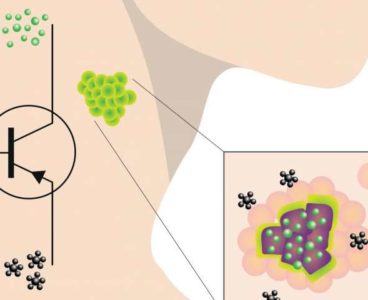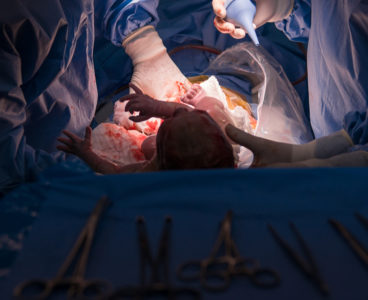Now you can use tattoos for more than just artistic self-expression. Physicians have been using tattoos on patients to mark an area for future treatment—especially for non-melanoma skin cancer, such as basal cell carcinoma. However, the ink could be troublesome. “Commercially available tattoo pigments possess several issues, which include causing poor cosmesis, being mistaken for…
Breakthrough Technology Helps Detect Cancer Cells
A new nanotechnology technique can now resolve the challenge of malignant tumor detection due to strong genetic and histological differences in cancerous tissue. The nanoscale fluorescent probes switch on in the presence of cancer cells, helping surgeons eliminate tumors in mice without harming healthy tissue, according to a study published early this week. The potentially…
Regenerative Medicine Physician Named 2016 Innovator of the Year
Anthony Atala, M.D., is a pediatric surgeon by training. He often performs surgery on his youngest and most vulnerable patients. And it’s no easy task for him. “There’s nothing more devastating than being in the operating room and doing surgery on patients where you’re putting things in that really don’t belong there, but you know…
C-Sections May Be Causing Evolutionary Changes, Says Study
What if you were told that there’s a method to that emergency C-section madness that you’ve had or that your wife has gone through? A new study has found statistical evidence that an increase in the number of mothers giving birth via cesarean section (the surgical delivery of a baby) over the past several decades…
New Technique Saves More Lives by Vaccinating Fewer People
Vaccination skeptics and doctors alike—take heed—there’s a new mathematical method that prevents epidemics by vaccinating fewer people than before. Scientists at the University of Aberdeen in Scotland who developed this method call it “explosive immunization,” as, they say, it’s the fastest and most efficient way to prevent the spread of disease. The method uses complex…
Bridging the University-Industry Divide in R&D Collaborations
Collaboration in research and development between academia and industry has been the main driver for the development of innovative technologies for many years and should not be overlooked. The relationship between these two institutions should be a symbiotic one, according to Joy Goswami, assistant director at the Office of Economic Innovation and Partnership at the…
Why STEM, Diversity Should Go Hand in Hand
“In order to survive, organizations need to diversify; we need more women and we need more minorities in traditional engineering,” said Amy Belton, Ph.D., a biomedical life scientist who spoke at the second annual R&D 100 Conference in Washington, D.C., earlier this month. In her session titled “The Impact of STEM and Diversity in the…
3D Printing & Plastic Bone Replacement Breakthroughs
Bone regeneration is a critical need in the United States. Each year, 209,000 procedures require craniomaxillofacial grafts for patients undergoing facial reconstructive surgery. Currently the sole option surgeons have is to take another bone, break it and fit it into a patient’s facial structure, which is not the ideal solution. In comes Prof. Warren Grayson, Ph.D., and his team who…
R&D 100 Conference Day 3: 2017 Global Funding Forecast
R&D 100 Conference Day 2: Innovate the Way You Innovate!
Forget everything you’ve ever learned about innovation and invention. According to Stephen Shapiro, the brain is not created for innovation, but rather for survival. “Don’t think outside the box, find a better box,” said the hall-of-fame speaker while delivering the second keynote on Thursday, Day 2 of the second annual R&D 100 Conference in Washington,…
R&D 100 Special Report: Moon Shot Unicorns Waiting to Be Tapped
According to Rosemarie Truman, there are more than 150,000 federally funded inventions available for further development and commercialization at universities, hospitals, federal labs and other research institutions, but many of them don’t make it into the marketplace. Some of these inventions are highly promising and could produce new drugs or launch new markets. Statistically, 1.28…
Reinstating Feel in Artificial Limbs for Amputees
Study: What Happens to a Frequent Liar’s Brain
Study: Good Yeast vs. Bad Yeast, the Differences Unveiled
R&D 100 Flashback: VUV Analytics’s VGA-100 for Gas Chromatography Detection
R&D 100 Flashback: Rigaku’s Progeny ResQ Speeds Up First Response Effort
Study: A Peek Inside a Habitual Short Sleeper’s Brain
Have you ever wondered why some people who sleep fewer hours feel groggy and unrefreshed, while others feel no effects at all? A group of researchers at the University of Utah did—and as a result published a paper yesterday in Brain and Behavior, about finding patterns of neural connections in the brains of so-called “habitual…
R&D 100 Flashback: 908 Devices’ M908 Utilizing High-Pressure Mass Spectrometry
R&D 100 Flashback: LANL’s SHMTools for Aerospace, Civil & Mechanical Infrastructure
Study: Why Do Women Outlive Men?
Why do women live longer than men? That is the million-dollar question that no one has yet been able to answer. But two researchers are looking more closely at this age-old riddle. Steven Austad, Ph.D., and Kathleen Fischer, Ph.D., of the University of Alabama at Birmingham explored this phenomenon in a perspective piece published in Cell Metabolism.…
A Look Back at R&D’s Innovator of the Year—Larry Page
One of R&D Magazine’s top individual awards—The Innovator of the Year—is presented each year to a person or team who has demonstrated leadership, creativity, entrepreneurial spirit and success in the pursuit of science and technology. Prior recipients of this Innovator of the Year Award—which has been presented for the past 15 years—have made significant advances in…
R&D’s Scientist of the Year—Starting 50 Years Ago with the Pioneer
Every year, R&D Magazine is privileged to choose groundbreaking innovators for the annual top science award—the Scientist of the Year. For half a century, this prestigious award has recognized many of the world’s distinguished scientists and most accomplished researchers. Without exception, its recipients have made substantial contributions to their field of study, including material science, physics,…




















